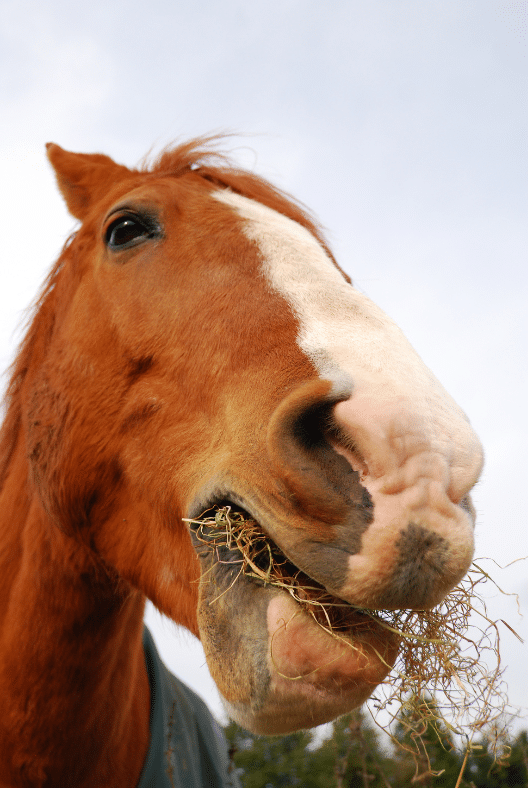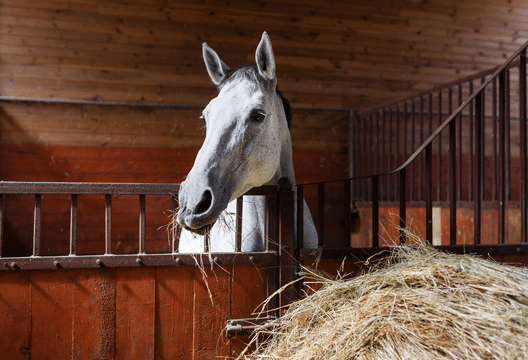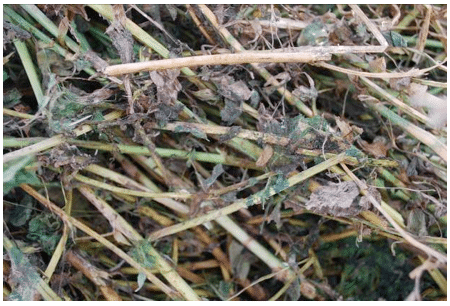What is the Best Type of Hay for Horses?
Affiliate Disclaimer: This page contains affiliate links. We may receive a commission for purchases made through these links.
 The types of hay you feed your horses has a huge impact on their health, energy levels, and performance. The wrong type of hay can irritate your horse’s lungs and cause respiratory problems and heaving. Low quality hay can contain poisonous weeds or moldy hay that can cause permanent lung damage.
The types of hay you feed your horses has a huge impact on their health, energy levels, and performance. The wrong type of hay can irritate your horse’s lungs and cause respiratory problems and heaving. Low quality hay can contain poisonous weeds or moldy hay that can cause permanent lung damage.
Growing up, I had a chestnut quarter horse mare. She had a great personality and was a lot of fun to ride – and she was very food-motivated. Unfortunately, the hay we had was often dusty and she was extra sensitive to dust. As she reached her late 20s and early 30s, the dust made her cough whenever she went faster than a walk.
I learned firsthand just how big a difference good hay can make. We would have to soak my horse’s hay to reduce the dust, then feed it to her right away so it wouldn’t get moldy. It made a huge difference in her health so she could enjoy her retirement more comfortably.
If you want to help your horse perform better, feeding them the right hay is essential. Choosing the right hay for your horse will help your horse avoid respiratory problems and stay happy and healthy. The type of hay that’s right for your horse depends on how much your horse’s breed, age, and activity level.
How to Choose Between Grass Hay and Legume Hay
There are two main types of hay for horses – grass hay and legume hay. Both of these types of hay have unique benefits and disadvantages, so choosing which type is right for you will depend on your horse’s diet and preferences.
Benefits of Grass Hay
This type of hay is high in fiber, and low in protein and energy. It’s less nutrient-dense, which means your horse will have to eat more hay to feel full. This is beneficial because it mimics the natural grazing pattern in which horses fill their stomachs slowly and steadily throughout the day.
Grass hay is a great choice of hay for horses who aren’t expending much energy, horses that are doing only light-work, retired horses, and easy keepers. Feeding your horse grass hay will keep your horse busy grazing all day and prevent them from finishing their hay quickly and getting bored.
The downside to this type of hay is that it might not give your horse enough energy if you have a hard-working horse, a growing foal, or a pregnant mare. These horses will need more nutrients and protein than retired horses or stall-bound horses.
Some common types of grass hay include: Kentucky bluegrass, fescue, orchard grass, bermudagrass, bahia, bromegrass and timothy hay.
Benefits of Legume Hay
Legume hay has a higher level of nutrients and minerals, and provides your horse with more energy. This type of hay is rich in protein, calcium, and vitamin A. Legume hay’s high protein and nutrient density can also make your horse thirstier, making it a great tool for keeping your horse hydrated as well.
Legume hay is an excellent option for performance horses, growing foals, lactating mares, and horses that need a lot of energy and nutrients. This type of hay is generally too rich in nutrients for an older retired horse or an easy keeper, feeding them this type of hay might make them too energetic or restless.
There are some disadvantages to this type of hay for horses. First, since legume hay is high in calcium, you might need to add a phosphorous mineral supplement to your horse’s feed to balance their diet. Second, certain types of legume hay are dustier and often have a certain type of mold that is harmless but can make your horse slobber a lot.
Some common types of legume hay include: alfalfa, red clover, white clover, and birdsfoot trefoil.
Finding the Right Match – What Is the Best Type of Hay for My Horse?
Different types of hay cause different energy levels. The hay that works best for your horse might not work well for your neighbor’s horse.
For example, a grass hay like timothy hay might be perfect for an easy keeper that munches on hay in his stall all day. Feeding that same horse something rich like alfalfa might shoot his energy levels through the roof and have him bouncing off the barn walls.
That’s why it’s so important to find a hay that will meet your horse’s unique energy needs. Here are some important factors to consider when deciding which type of hay is right for your horse:
#1: Your horse’s energy needs
If your horse is working a lot each day, he will need a type of hay that’s richer in nutrients so it can give your horse more energy. But, if you have a retired horse or a horse that stays mainly in his stall, you can choose a hay that’s low in protein and energy. Typically, grass hay has enough protein and energy for the majority of horses. If your horse is growing, lactating, or working hard, you will need a more nutritious type of horse hay.
#2: Your horse’s breed
There are certain types of horse breeds that have specific nutritional requirements because of their medical histories and health challenges. For example, draft breed horses are prone to a certain muscle disease called EPSM that can cause weakness and muscle wasting. That’s why these horses have to have a specific balance of sugars and starches in their feeds.
Ask your veterinarian if your horse needs a specific type of hay or what hay combination they recommend.
#3 Your horse’s body type
Your horse’s age and weight also affect what types of hay will be best for his diet. If your horse has a high metabolism, he might benefit from more calories, while a calmer horse with a slower metabolism might need fewer calories.
If your horse is underweight and is used to eating grass hay, you’ll want to try feeding more, then try adding some alfalfa hay to get your horse to a healthy weight. If your horse is overweight, you’ll want to try switching to a lower-calorie hay. Most experts and veterinarians recommend feeding the same amount of hay and switching to a lower-calorie type of hay, rather than just reducing your horse’s hay intake.
The 5 Best Types of Hay for Horses

#1 Timothy Hay
Timothy hay is number one on the list because of its high quality and high protein content. This type of hay has natural oils that promote a beautiful, shiny coat and healthy digestion. Timothy hay is a very popular grass hay, but it can be a little expensive (especially if you are shipping it across the country). Most experts recommend buying the second cut, since it has less weeds but still has high nutritional value.
#2 Alfalfa Hay
Alfalfa hay is our top choice for legume hay – it’s high in protein, calcium, and vitamin A – and has high palatability, meaning your horse will love it. This type of hay is also very expensive, but since it’s a legume hay, your horse will need less hay to feel full. In fact, this type of hay has 120% more energy than oat hay (when compared per unit), which means your horse can eat less and still get all the required nutrients.
#3 Orchard Grass Hay
This type of grass hay is a cheaper alternative to Timothy hay, and it has a low weed content, making it a great option for your horse. Orchard grass hay is a nutritious hay that has a very balanced amount of calcium and phosphorus levels, while being high in protein as well.
#4 Oat Hay
Oat hay is a legume hay that’s less expensive than alfalfa hay, but still nutritious and good quality. Make sure that nitrate levels in your oat hay are acceptable, because sometimes depending on where the hay is grown, they might be too high. This type of hay is very effective for older retired horses.
#5 Bermudagrass Hay
Bermudagrass hay is just as nutritious as timothy hay, but it’s better if it’s mixed with legume hay. This type of hay has two disadvantages – first, it’s expensive because it’s difficult to produce and second, it has a high weed content.
Many horse owners decide to mix different types of hay to create the perfect combination for their horse’s energy needs. A combination of legume and grass hay can give your horse a medium amount of energy, a better calcium balance, adequate protein, and a healthy amount of fiber.
Test your horse’s health with this Equine Health Test that uses bioresonance technology to check your horse’s nutrition, metals, and minerals imbalances:
Never Feed Your Horse This Type of Hay
No matter what types of hay you decide to feed your horses, always make sure that it’s good quality hay. Color and smell can tell you a lot about the quality of the hay you’re thinking about buying. Green, sweet-smelling hay usually means that the hay was cut, prepped, and baled quickly and stored properly. Brown or yellow hay could mean that your hay was rained on and not properly dried and has lost nutritional value because of leaching (loss of nutrients because of rain damage) and bleaching (loss of nutrients because of sun exposure).
Moldy Hay - Image Source: University of Wisconsin - Madison
Whatever you do, there’s one type of hay that you should never feed your horses – moldy hay. Mold can have serious repercussions for your horse’s health. It can inflame their respiratory tract, cause breathing difficulties, and lead to heaves – a chronic breathing disease that worsens over time. It can also damage a horse’s stomach and cause digestive problems. Many times, mold can even be fatal.
Why You Should Always Check Your Horse Hay
Moldy or dusty hay for horses can cause serious health problems. That’s why it’s essential to always check your hay before feeding it to your horses. No matter what type of hay you decide to buy, you always need to double check that it’s safe for your horses.
I remember spending time at the stable inspecting the hay we bought – making sure that it was free of dangerous mold, weeds, and blister beetles. These annoying little beetles are commonly found in alfalfa hay, and they secrete a chemical called cantharidin when they are crushed or injured. This chemical can cause cholic, fever, and even death in horses.
To inspect your hay, look for gray or black spots that could mean the hay is moldy, weird smells and dusty areas of the hay. Make sure there’s no little bits of metal or plastic or weeds in the hay. Remove all the hay that is moldy or dusty before feeding it to your horses.
Tips for Storing Your Horse Hay
Properly storing your horse hay can prevent molding, rain damage, and loss of nutrients because of sun exposure. When hay is left outside unprotected from the elements, rain damage can decrease the amount of carbohydrates in the hay and prevent the hay from drying properly. If it’s sunny and dry where you live, storing your hay outside can bleach your hay, turning it yellow or brown and destroying the vitamin A nutrients in the hay.
Read More: Hay Racks and Hay Pods: Get the Facts on Hay Storage
To avoid these problems, always store your hay in a covered area to protect it from rain and sun. Make sure the area has good ventilation to prevent mold. Use boards or pallets to raise your hay off the ground and keep it dry. Allow for some spacing between your hay bales to allow for ventilation as well.
Remember, the longer your hay is stored, the less nutritional value it will have when you feed it to your horses.
How Much Hay Should a Horse Eat in a Day?
Hay is essential in a horse’s diet, and feeding your horse the right hay makes all the difference in their health and performance. But how much hay should your horse eat every day?
On average, your horse will need to eat about 2% of it’s body weight in feed every day. So, if your horse weighs 1,000 pounds, he’ll need to eat about 20 pounds of dry feed every day.
Of course, this is just a general guideline. If your horse is working a lot, pregnant, or is a young mare, it will probably need to eat more than 2% of it’s body weight to meet its nutritional needs.
Frequently Asked Questions
What is the best type of hay for horses?
Timothy hay is one of the best types of grass hays for horses, and alfalfa hay is one of the most popular and high-quality legume hays. Most horse owners do use a combination of alfalfa and timothy hay.
What is the best color hay?
Usually, bright green, fresh-smelling hay is the best. Yellow or brown hay could indicate that the hay has been damaged by rain or sun exposure.
What type of hay is best for foals and growing horses?
Alfalfa hay is a great option for foals because it is high in nutrients and minerals and provides them with the energy they need to grow and mature. It’s also high in calcium which is essential for bone development in young horses.



